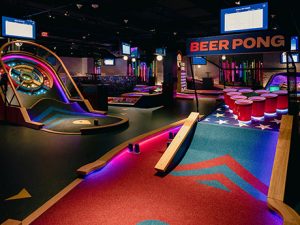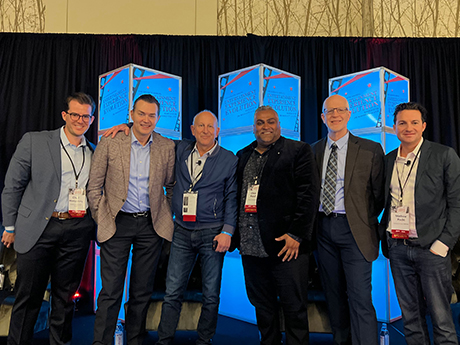By Taylor Williams
With the COVID-19 pandemic largely in society’s rearview mirror and warm weather months approaching, Americans are fired up to recoup lost time at their favorite restaurants, bars and entertainment venues.
But the collision of this pent-up demand with 40-year inflationary highs means that many consumers are going to be more selective about where they eat, drink and source entertainment. To that end, meals, drinks, games and activities must offer a truly unique experience to justify consumer spending of their stretched dollars and to capture the Holy Grail of repeat spending/visits.
That’s not to say that run-of-the-mill, traditional food and beverage (F&B) and entertainment concepts won’t rebound to some extent. But the concepts that deliver their offerings to customers in ways that are truly unique and memorable will be the ones that recognize the strongest sales growth and build the most enduring brand loyalties.
Strategies, philosophies and exemplary practices that go into making this endeavor a reality were at the forefront of a panel discussion at the seventh-annual Entertainment Experience Evolution conference that took place in mid-March in Los Angeles. Hosted by Shopping Center Business, the flagship publication of Atlanta-based France Media Inc., the event drew more than 500 retail, restaurant and entertainment developers and operators.
These individuals, all of whom are leading the post-pandemic resurgence of the asset class and routinely devising creative concepts and experiences, spoke during a panel entitled “Making Magic in a Post-COVID World.” David Parrish, principal at Cleveland-based design firm RDL Architects, moderated the discussion.
Defining ‘Unpredictability’
Panelist Matt Focht, CEO of retail, restaurant and entertainment consulting firm Emerging, kicked off the dialogue by calling attention to a shift in consumer behavior as it pertains to F&B uses within a center. In the 2000s, he said, consumers would come to lifestyle centers with heavy F&B components without set plans in mind and allow the bars and restaurants to guide their cross-shopping activities.
Today, however, people are much more intentional about where they eat and drink and are less likely to make impromptu visits to other onsite retailers or restaurants. Given this prevailing consumer mindset that centers on mission-driven visits, it’s become all the more important for F&B and entertainment concepts to offer something unique, Focht reasoned.
“People used to just show up at a center, then decide where they wanted to go and do some browsing and cross-shopping, which helped everybody,” Focht said. “Now, since people are planning so much more, they’re placing greater emphasis on unique experiences. Google searches on the word ‘unique’ shot up 94 percent between 2020 to 2021. So what we see is that social entertainment concepts today are wrapping cool digital tech around traditional platforms, which allows for more unpredictable experiences.”
Focht pointed to Puttshack and its automatic scoring systems — as well as Electric Gamebox and its arcade-style games with projection mapping, touchscreens, motion tracking and surround sound — as examples of concepts that are effectively merging traditional entertainment vehicles with cutting-edge tech. This combination is proving successful in creating the unprecedented type of experience that consumers deem worthy of a preplanned, intentional visit.

Pictured is the mini golf course of Puttshack in Atlanta, a new entertainment concept that is merging traditional games and activities with 21st-century technology to make the experience more unique and memorable for customers.
“There’s a hunger for the unexpected,” Focht concluded. “So developers need to think about what kind of retail, restaurant and entertainment uses they can bring in that offer a truly unpredictable experience. The concepts that do this are winning the battles for mindshare and consumer awareness among both families and younger generations.”
Other panelists echoed the importance of cross-generational appeal in today’s entertainment market. Chad Montgomery, director of real estate development for Andretti Karting & Games, discussed how old-school entertainment concepts can incorporate new-age tech features to captivate consumers and keep them coming back.
“Our facilities have three tracks, one for juniors, one for intermediate racers and one for adults, because we’ve found that it’s very important to hit all the age groups,” Montgomery said. “Being six inches off the ground while going 35 miles per hour really creates the sensation of being on a thrill ride.”
While go-kart racing is the marquee attraction at Andretti facilities, which typically span about 100,000 square feet, it’s far from the only one. The concept, which has six locations across Georgia, Florida and Texas, also features dozens of new and classic arcade games, as well as group-focused activities like bowling, laser tag and virtual reality. Montgomery added that all of these attractions lend themselves to “Instagrammable moments” that are key to the magic-making process.
In the wake of COVID-19, people are more likely than ever to embrace any sort of reason to get out and celebrate. As such, many entertainment operators are seeing private parties comprise greater percentages of their revenue streams. To make the most of these events and deliver a truly unique experience, operators must train and allow their staffs to find small, yet creative ways to make them unforgettable for participants.
“About this time two years ago, we closed all our locations, but we were able to reopen them within about 90 days,” Montgomery said. “Upon reopening, we put major emphasis on our people, starting with our staff and empowering them to make sure guests would be comfortable, want to come back and encourage their friends to visit.”
Panelist Dale Schwartz, CEO of Pinstripes, a concept that combines bowling with food, drink and other games, stated that each of his 13 venues across the country hosts about 1,000 private events per year. The healthy volume of this segment of the market is a testament to the fundamental fact that people are inherently social creatures — a quality he intends to capitalize on as he grows the Pinstripes brand.
“We’re really leaning into celebrations and parties,” said Schwartz. “Anywhere from 30 to 40 percent of the reservations we get are anniversaries or birthdays, and we’ve embraced that by having personalized medallions made, presenting cards and complimentary food items and giving away Pinstripes merchandise. Anything we can do to create that fun theater, we do and will continue to do.”
Getting Emotional
Panelist Chuck Steelman concurred with the importance of generating social media-friendly content as a means of generating emotional connections — which by definition tend to be unique and memorable. Steelman serves as vice president of customer experience, programing and partnerships at Trademark Property Co., a mixed-use developer and operator based in Fort Worth, Texas.
“With brick-and-mortar retail, there are so many ways to build emotional connections with people, mostly by offering them an experience they can’t get online,” he said. “If you can do that, you build loyalty, and you see people coming back to your center much more often.”
Steelman shared anecdotal evidence of some of the ways in which Trademark has established these emotional connections with customers. He cited a holiday shopping experience at a Trademark property that, replete with Kodak moments, centered on children riding a train into a built-out replica of the North Pole to see Santa Claus. The attraction included a “holiday Instagram museum” for families to catalog the experience.
“When we saw the looks on the faces of the kids, as well as how their parents reacted to those looks, we knew we’d made a significant impact on those customers from an emotional standpoint,” Steelman said. “The difference between being good and great is paying attention to the details; it’s those little things that really make customers’ experiences memorable.”
Toward the end of the discussion, Steelman dove a tad deeper on what it really takes to create a memorable experience, leaving the audience with a profound, philosophical take on the innate love of surprise that pervades human nature.
“You really have to disrupt customers’ expectations of normalcy and do things that make their expectations different each time,” he said, citing Trademark’s installation of a 24-foot replica of Mount Rushmore on the ice rink at the Galleria Dallas on Presidents Day. “It’s about jarring the customer, making them stop and say, ‘that’s pretty cool.’”


